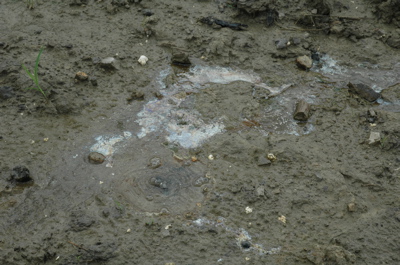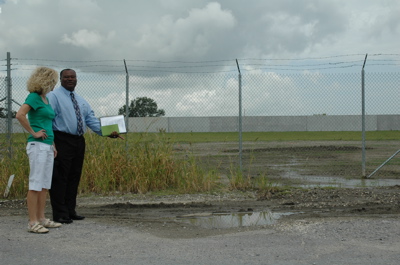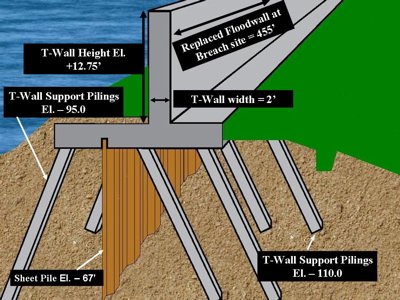
Mark Twain once said about editors --" I am not the editor of a newspaper and shall always try to do right and be good so that God will not make me one."
The same might be said about Tim Doody, president of the eleven-member Southeast Louisiana Flood Protection Authority-East in New Orleans. He might well be asking himself the question Twain posed in terms of his appointment to the local levee authority.
Doody has held the volunteer post since July 2007. He makes it clear right off the bat that he is not an engineer, but a CPA and director of the Chafee McCall law firm.
Doody has his hands full right now trying to seat an independent review panel to look at leaks on the 17th street drainage canal that failed catastrophically during the aftermath of hurricane Katrina, flooding much of New Orleans.

Image: New seepage near 17th Street Canal on Tuesday
In March of this year, The New Orleans Times Picayune summarized comments from an outside engineering expert from California who addressed the 17th Street Canal leaks. "Water persistently seeping out of the 17th Street Canal near the repaired levee and floodwall indicates serious flaws in the design, not only of that levee section but of much of the multibillion-dollar 100-year hurricane protection for the region," the Times reported. The newspaper referred to comments made by University of California-Berkeley civil engineering professor Robert Bea.
The local levee authority has ownership of both the flood control and river control levees in the parishes in New Orleans. But, the USACE (Army Corps) has responsibility for the new construction on the 17th Street Canal.
"I have been in touch with the American society of Civil Engineers (ASCE) and finally compiled a list of fifteen names of truly independent engineers who have not worked for the Army Corps of Engineers (USACE)," Doody said in a phone conversation. He has to find three engineers from that list who are willing to examine what is a happening along the levee bank where water has been bubbling to the surface along the repaired breach since at least March 2008.
Doody also made it clear that he takes his post very seriously.
"I truly feel a sense of duty in serving on the board -- I lost my home, along with my family (all have relocated) as a result the hurricane, " Doody said.
Corps engineers maintain that the seepage is not cause for alarm.
Randall Cephus, press officer for the New Orleans USACE, came out to the levee with us to take some more photos of the bubbling water, which appeared to have increased in flow since Sunday. Cephus came out on short notice.

Image: Randall Cephus POA USACE and Sandy Leventhal of levees.org
When asked what the USACE planned to do about the situation, Cephus said that the Corps did not want to disturb the ground around the three points of flowing water, since it would essentially "taint the investigative work" of the planned review board.
We noted that direct access to the leaks had been reinforced with a double padlock -- installed since our initial visit and report two days prior. Senator Mary Landrieu (D-LA) was in New Orleans on Monday, and after Levees.org mailed her photos of the leaks and ducks swimming in pooled water on road nearby, Landrieu's office said that the Senator would be in contact with the New Orleans Corps office to make sure they were addressing the issue.
The Corps subsequently sent an investigative team out to the site and determined that the flowing water from the three points were brackish, meaning they have a salt-water component and were definitely coming from the drainage canal.

POA Cephus provided a detailed diagram of the new levee construction, as well as the water reports.
Engineer H.J. Bosworth who works with the New Orleans watchdog group, levees.org, indicated that the new construction is the "best possible" design after we showed him the diagram. Bosworth speculated that part of the problem might be in the fill material used to backfill the levee wall, but had no way to know for certain. Water will find a way through any porous material, especially if vegetation such as sticks or branches provides a channel, he said.
Bosworth's detailed response is as follows:
"The T-wall in the image you have is an excellent design for a flood protection element. The reinforced concrete "T" is supported by piles driven into soil beneath the surface and typically are used in the design of important structures here in south Louisiana. The design capacity of the piles is usually half of what they are tested to support - giving them a safety factor of 2! The codes for designing structures of reinforced concrete are the same as what most civil engineers use to design concrete elements of buildings and bridges. They are absolutely safer than levees with a theoretical safety factor of 1.3.
"Lateral flow of ground water is typically stopped or at least kept to a minimum by the steel sheet pile 'cut-off' wall beneath the 'T-wall'
"I am sure the folks that just had their communities flooded up river from us wish that their government had spent a few more dollars and had constructed a few miles of T-walls around them instead of the levees that failed to protect them. The technology is not new. Too often, the Corps opts for levees to save money rather than asking Congress for enough funding for reliable and stable concrete structures."
As for the ducks, they were gone (fate unknown), and Cephus took his own photos of the pooled water. He was uncertain whether the correct duck area had been tested originally. A water test did come back on Tuesday that indicated water pooled on the road was not brackish and could possibly have come from a leaking water main. We rechecked the duck area.
On a Lighter Note--Cheney responsible?

On a lighter, not, and those living in New Orleans could certainly use some levity -- we received a tip from The Levee that Dick Cheney was behind the disappearing ducks and levee leak, but we have been unable to confirm that report.
The bottom line in this report from New Orleans is that residents will have to wait for the review panel for more answers.
This column cross-posted on OEN
